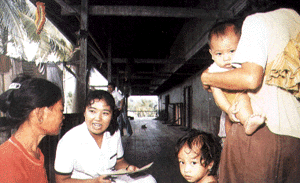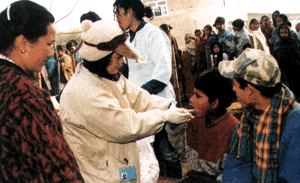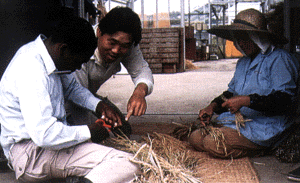Official Development Assistance (ODA)
Japan's ODA Annual Report (Summary) 1995
1. Japan's ODA Backed by Popular Support and Participation
The international community today is in the midst of a most important transition. Since the collapse of the Cold-War structure, the world, still struggling with instability and uncertainty, is seeking a new framework for peace and prosperity.
Although the global economy as a whole is on a growth track, it has yet to contend with a number of serious problems, such as dislocations caused by the shift of the economic systems in the Central and Eastern European countries and the former Soviet Union to market-oriented economies, as well as growing unemployment. What is more, many of the developing countries are still suffering from poverty. In many regions of the world, political conflicts and ethnic and religious strife erupted, and the refugee problem caused by these conflicts has reached crisis proportions. Furthermore, there emerged new problems affecting a multitude of countries, such as deterioration of the global environment, population, the HIV/AIDS epidemic, and the need for empowerment of women in developing countries (WID).
Given the complexity and the worldwide scale of these problems, Official Development Assistance (ODA) issues must be taken up in the context of a changing international environment. Reflecting such a global situation, the demand for ODA has grown and become increasingly complex and diverse. Despite the fact that the industrialized countries' capacity to provide external assistance shows a decreasing trend, Japan has been consistently seeking to expand its ODA in the belief that ODA should constitute an important part of Japan's contributions to the international community and a potential diplomatic instrument of the nation as well. As a result, Japan became the world's largest donor of ODA.
Japan's efforts to increase its ODA on a continuing basis would not be fulfilled without the broad-based understanding and support of its people and their participation in the implementation of its ODA programme.
2. Sense of Awareness and Responsibility as a Leading Donor
Japan being the world's largest aid donor, its aid policy and the implementation of projects are closely observed by the international community. In order to increase the amount of ODA, it is essential to win the understanding and support of the Japanese people. Bearing this in mind, Japan, for its part, clearly defines its philosophy in the three areas described in the following:
1) Philosophy and principles: Does Japan have a firm philosophy and principles for ODA?
2) Policies: Does Japan have aid policies in anticipation of changes in coming years?
3) Implementation: Is Japan implementing projects effectively and efficiently?
Appendix
- Chart 1-11
- Chart 1 Japan's ODA in 1994 (By type)
- Chart 2 Distribution of Japan's Bilateral ODA by Sectors (on a Commitment Basis)
- Chart 3 Trends of Major DAC Countries' ODA (On a net disbursement basis)
- Chart 4 ODA of DAC Countries
- Chart 5 Trends of Japan's Bilateral ODA (Regional Distribution)
- Chart 6 Ten Major Recipients of Japan's Bilateral ODA
- Chart 7 Ratios of Major Countries' ODA Contributions to Regions (1993, on a net disbursement basis)
- Chart 8 Yen Loans to Indonesia, Thailand and Malaysia (By sector)
- Chart 9 Changes in Procurement Conditions on Japan's ODA Loans
- Chart 10 Procurement of ODA Loans (by country)
- Chart 11 Bilateral and Multilateral Aid of Japan in the Environmental Sector
- The Fifth Medium-Term Target of ODA (outline)
- Japan's Official Development Assistance Charter (excerpt)



